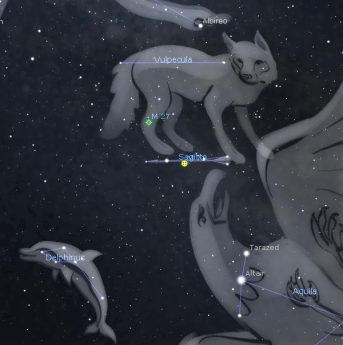This Week’s Sky at a Glance, 2025 Aug 16 – Aug 23
This Week’s Sky at a Glance, 2025 Aug 16 – Aug 23
One of the prettiest constellations can be seen halfway up in the southeastern sky around 10 pm. Delphinus the Dolphin is composed of a small diamond-shaped asterism with a star tailing off to the right, and it doesn’t take a lot of imagination to picture a dolphin leaping out of the sea. Although its stars are not bright, its compact shape is eye-catching. Below it are the watery constellations of Capricornus, Aquarius, Piscis Austrinus and Pisces. In mythology, Poseidon had designs on the sea nymph Amphitrite but she hid on him. A dolphin kept track of her and eventually convinced her that the sea god was an okay guy, and it was rewarded with a place of honour in the sky. The diamond part of the constellation has also been called Job’s Coffin but the origin of this is unknown.
Above Delphinus, and within the Summer Triangle, are two other small constellations called Sagitta the Arrow and Vulpecula the Fox. Like Delphinus, Sagitta does resemble its namesake but apparently the fox is too sly to give itself away readily. Sagitta is supposedly the arrow shot by Hercules to kill an eagle (Aquila), which had been commanded by Zeus to peck out the liver of Prometheus each day to punish him for giving humans the secret of fire. Binoculars might reveal the tiny gaseous remnants of an expired star, called the Dumbbell Nebula or M27, above the arrowhead, and the Coathanger Cluster is to the upper right of the fletching.
This Week in the Solar System
Saturday’s sunrise in Moncton is at 6:20 and sunset will occur at 8:25, giving 14 hours, 5 minutes of daylight (6:26 and 8:29 in Saint John). Next Saturday the Sun will rise at 6:28 and set at 8:13, giving 13 hours, 45 minutes of daylight (6:35 and 8:17 in Saint John).
The waxing third quarter Moon is nearing the Pleiades this Saturday. It joins up with Jupiter and Venus on Tuesday and especially Wednesday before visiting Mercury on Thursday. Jupiter and Mars double the space between themselves over the week as they move in opposite directions. Mercury rises about 90 minutes before sunrise all week and more than doubles its brightness over that period. Saturn rises before 10 pm this weekend and a few minutes earlier each evening, with Neptune less than half a binocular field above it. Being relatively dim and setting about 80 minutes after sunset, Mars will be a difficult binocular target. But, if you can pick it out, and with Uranus a binocular field below the Pleiades, this is a good week to attempt an all-planet day or night.
The RASC NB star party at Fundy National Park takes place next Friday and Saturday, August 22-23. See the rascnb website for details.

